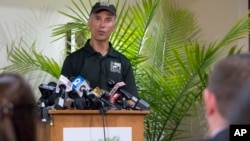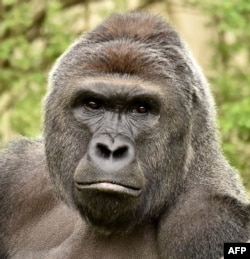Police in Cincinnati, Ohio, are investigating possible criminal charges in the shooting death of an endangered male gorilla at the local zoo after a 4-year-old boy tumbled into the huge ape's pen, putting himself in grave danger.
The incident was caught on a cellphone camera and has caused outrage among animal lovers around the world.
Police say they are still gathering information that will be passed over to county prosecutors.
A spokeswoman at the U.S. Department of Agriculture tells VOA that the agency is determining whether any federal animal welfare laws were violated.
A group called Stop Animal Exploitation Now is demanding that the zoo face federal charges. It says in a letter to the USDA that the zoo failed to "adequately construct this enclosure to protect both the public and the animal."
The zoo was cited in March for failing to close two doors, allowing two polar bears to enter a service area while the zoo was open. The bears were tranquilized and returned to their enclosure. No people or animals were hurt.
The zoo has not commented on the current police investigation.
Zoo stands its ground
But zoo director Thane Maynard said the barriers around the gorilla’s pen enclosure were adequate. It is still unclear how the child got past those barriers. He also said the zoo had no choice but to kill the 17-year-old gorilla, named Harambe.
A cellphone video shows Harambe dragging the boy through a shallow moat filled with water. Several times, the gorilla looked to be gently touching the boy and stood him up on both feet as if he was trying to protect him.
But just as suddenly, Harambe pulled the boy through the moat to a different part of the pen, with the boy's head hitting the concrete. Harambe had control of the child for at least 10 minutes before the zoo's Dangerous Animal Response Team shot him to death.
Many animal lovers say killing Harambe was unnecessary. But with his pen surrounded by screaming and excited people, Maynard said Harambe was clearly agitated, disoriented and acting erratically.
Maynard called Harambe "unpredictable" and said tranquilizing the 181-kilogram ape would have taken too long. He described lowland gorillas like Harambe as dangerously strong, with arms as large as a man's leg and hands powerful enough to crush a coconut.
The boy who tumbled into the gorilla pen was, remarkably, unhurt and was sent home after several hours in the hospital. It is unclear if his parents will face charges.
Public outrage
The zoo tragedy is one of the hottest topics on social media. More than 334,000 people have signed a petition called "Justice for Harambe" on the Change.org website, calling for the boy's parents to be charged with negligence.
A Facebook page — also called "Justice for Harambe" — had more than 120,000 "likes" as of Tuesday afternoon.
"Social media provides a way for people to make their voices heard," Makana Chock, a Syracuse University social and media psychology expert, told VOA. "Sometimes, this can lead to social movements and societal change, such as protecting an endangered species of gorilla."
Harambe was a western lowland gorilla. They can be found in the dense rain forests of Cameroon, the Central African Republic, the Democratic Republic of Congo and Equatorial Guinea. Their population has declined by more than 60 percent over the past 20 to 25 years because of poaching and disease, according to the World Wildlife Fund.









